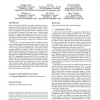151 search results - page 27 / 31 » Semantics-Aware Malware Detection |
105
Voted
CCS
2010
ACM
14 years 11 months ago
2010
ACM
Online social networks (OSNs) are popular collaboration and communication tools for millions of users and their friends. Unfortunately, in the wrong hands, they are also effective...
DIMVA
2009
15 years 21 days ago
2009
Drive-by download attacks are among the most common methods for spreading malware today. These attacks typically exploit memory corruption vulnerabilities in web browsers and brows...
111
click to vote
DIMVA
2010
14 years 11 months ago
2010
Abstract. In the escalating arms race between malicious code and security tools designed to analyze it, detect it or mitigate its impact, malicious code running inside the operatin...
IEEEARES
2010
IEEE
15 years 6 months ago
2010
IEEE
—Program obfuscation is often employed by malware in order to avoid detection by anti-virus software, but it has many other legitimate uses, such as copy protection, software lic...
ICDM
2008
IEEE
15 years 6 months ago
2008
IEEE
To cope with concept drift, we paired a stable online learner with a reactive one. A stable learner predicts based on all of its experience, whereas a reactive learner predicts ba...

